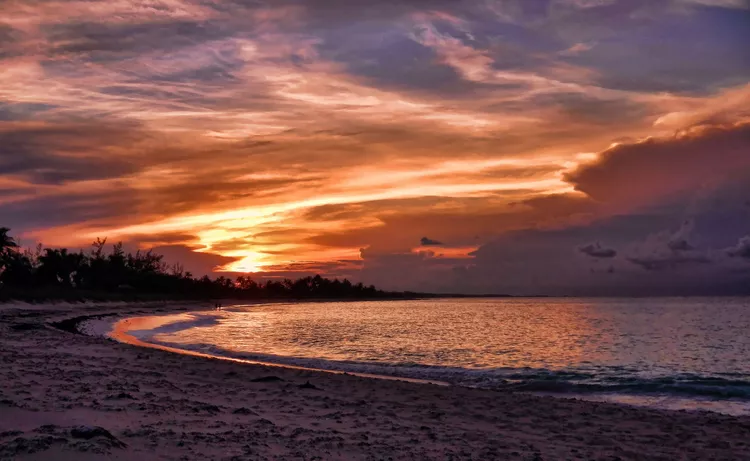Summary
There are more than 7,000 Caribbean islands. Some are household names, like Jamaica, Puerto Rico, and Aruba, while others are little more than rocks jutting out of the ocean.
In between, however, there are a surprising number of larger and more interesting islands that few travelers have ever heard of, much less visited. Here are a few of our favorite quiet island outposts in the Caribbean.
01. Turneffe Atoll, Belize

You usually hear the word atoll — meaning a ring-shaped coral island, reef, or chain of islands — associated with the South Pacific, but the Caribbean has its very own atoll off the coast of Belize. The Turneffe Atoll is about 30 miles long and 10 miles wide, sitting southeast of the better-known Ambergris Caye and Caye Caulker. About 150 mangrove islands are arranged around a central lagoon. Mariners are familiar with Mauger Caye due to its lighthouse, while the Turneffe Island Resort and Blackbird Caye Resort occupy a couple of the islands of the atoll. Just 20 miles off the Belize coast, the atoll is perhaps best known to divers.
02. Isle of Youth (Isla de la Juventud), Cuba

Historically known as the Isle of Pines, Cuba’s Isle of Youth may be the least-famous big island in the Caribbean, thanks in part to the longstanding (but finally changing) restrictions on travel to Cuba. The second-largest island in Cuba and the seventh-largest island in the West Indies, the Isle of Youth occupies 850 square miles south of Cuba’s Gulf of Batabano and is home to about 100,000 people.
“Discovered” by Christopher Columbus, the island has a long association with piracy and is thought to be the Treasure Island featured in the Robert Louis Stevenson classic of the same name. Fidel Castro was once imprisoned in the island’s infamous Presidio Modelo, and prior to the Cuban Revolution, it was a tourist destination for Americans, complete with a Hilton hotel. Today, the island’s tourism economy is a shadow of its former self, but Bibijagua Beach is still lovely, the island has a ton of history, and there are some great dive sites.
03. Isla de Providencia, Colombia

Sitting between Costa Rica and Jamaica, Isla de Providencia rises more than 1,000 feet from the Caribbean Sea and was once a Puritan colony and a hideout for pirate Henry Morgan. A Colombian outpost of mostly English speakers with a definite Caribbean tilt (many Rastafarians live here), the island boasts a large national park (Old Providence McBean Lagoon), is the center of the protected UNESCO Seaflower Biosphere Reserve, and is considered the quieter cousin to bustling Isla de San Andres, another Caribbean island of Colombia nearby.
The island has little formal tourism infrastructure, but you will find small villas, restaurants, bars, along with secluded beaches, great diving, and authentic, laid-back Caribbean island culture.
04. Isla la Roques, Venezuela

Fishing is the main attraction of Venezuela’s Los Roques archipelago, a lightly populated archipelago (and national park) about 80 miles north of the mainland, declared a national park in 1972. It’s a far cry from Venezuela’s famous Caribbean playground, Margarita Island.
The few travelers who come here fly into El Gran Roque, the only inhabited island, before transiting to small posadas or fishing resorts to go for bonefish, barracuda, tarpon, and other big game fish. What nightlife exists can be found on Gran Roque, but you’ll more likely spend your days fishing, laying on the beach, diving, and sailing, enjoying fresh local lobster before resting for the next day’s adventures.
05. Isla la Tortuga, Venezuela

This 60-square-mile island has always been known for its large population of sea turtles but has never been permanently inhabited. Unless you are a fisherman, you’re most likely to visit La Tortuga on a day cruise out of Caracas or Margarita Island that will bring you to one of the island’s unspoiled beaches or dive spots; local fishermen will sell you fresh lobsters that you can prepare for lunch.
06. Mayaguana, Bahamas

The Out Islands of the Bahamas are a fabulous destination for fishing, diving, and boating. Many of these islands are popular tourist destinations — the Exumas, Abacos, Bimini, Eleuthera, and Cat Island, to name a few.
Mayaguana, the most easterly of the Bahamas islands, is one of the least visited and least known. With a population of just 300 or so people, the 110-square-mile island is occasionally visited by travelers seeking pristine dive locations (including the sea caves of Northwest Point), bone fishing, and secluded beaches. The island’s endemic species of iguana give Mayaguana its Arawak Indian name.
07. Navassa Island, U.S.

Believe it or not, the rare visitors to this two-square-mile island off the southwest coast of Haiti are standing on U.S. soil: Navassa Island is a territory of the United States and has been declared a National Wildlife Refuge, although Haiti also claims the island as its own. The island, sitting between Haiti and Jamaica, has a historic lighthouse and a large population of sea birds, but no permanent human inhabitants (guano mines once operated here, and the scant remains of historic Lulu Town sit near Lulu Bay).
The National Wildlife Refuge protects the island, encompassing its population of red-footed boobies and lizards, along with the surrounding coral reefs and waters. However, it is closed to the public.





